Hawaii is unlike any other destination in the U.S.A. Besides the fact that the Hawaiian Islands are over 2,000 miles away from the North American continent, our tropical environment makes for an ideal place to grow all kinds of fruit that you don’t regularly see in your local grocery store. Even other parts of the U.S. that have a similar climate, such as Florida and Puerto Rico, don’t see the same variety in fruit that we do. A visit to a farmers market, roadside stand or hike through the jungle can lead to discovering things you’d only imagined existed in some fictional, tropical land. The funny thing is, essentially every fruit grown in Hawaii isn’t here naturally. While a few were brought by the Polynesians that first colonized the islands, the majority originate in the tropical Americans and Asia and were brought here in the last 150 years. Here’s some exotic fruit to keep an eye out for on your trip to Hawaii.
Breadfruit aka ‘Ulu
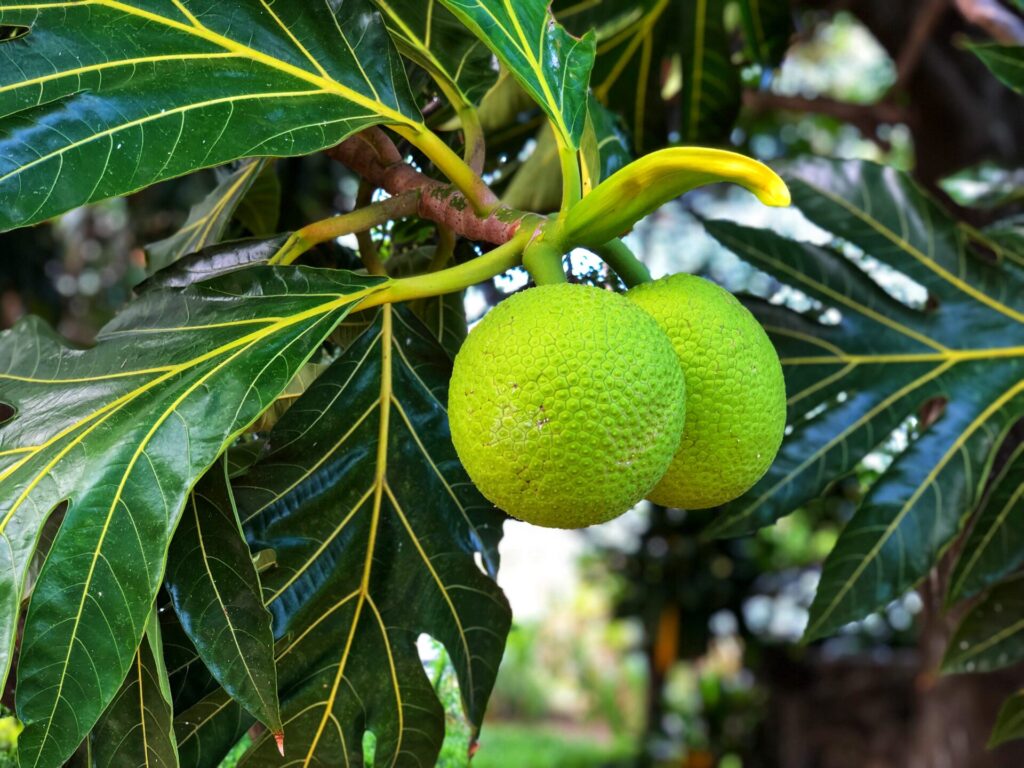 Breadfruit is what is known as a “canoe plant”, one of the staple plants brought by Polynesians to establish food crops across the Pacific. Called ‘ulu in Hawaiian, the starchy fruit grows on big, beautiful trees and carries a lot of cultural significance. In Hawaiian legend, the god Ku turned into a breadfruit tree to save his family and village from famine. The amount of fruit that just one tree produces is pretty amazing, with each fruit averaging between two and seven pounds. (This means just one fruit can be a meal for a whole family.) You’ll know it’s ripe when it begins to turn slightly yellow with brown spots and soft to the touch. It’s not something that can really be eaten raw; it should be cooked in some way. Though the fruit itself is pretty neutral in flavor (somewhat potato-like), it is extremely versatile. Besides the traditional way of roasting it in the coals of a fire, other popular cooking methods include frying it as chips, sautéed in butter, and even making it into a desert. Check out Pono Pies for some incredible and delicious examples of this fruit.
Breadfruit is what is known as a “canoe plant”, one of the staple plants brought by Polynesians to establish food crops across the Pacific. Called ‘ulu in Hawaiian, the starchy fruit grows on big, beautiful trees and carries a lot of cultural significance. In Hawaiian legend, the god Ku turned into a breadfruit tree to save his family and village from famine. The amount of fruit that just one tree produces is pretty amazing, with each fruit averaging between two and seven pounds. (This means just one fruit can be a meal for a whole family.) You’ll know it’s ripe when it begins to turn slightly yellow with brown spots and soft to the touch. It’s not something that can really be eaten raw; it should be cooked in some way. Though the fruit itself is pretty neutral in flavor (somewhat potato-like), it is extremely versatile. Besides the traditional way of roasting it in the coals of a fire, other popular cooking methods include frying it as chips, sautéed in butter, and even making it into a desert. Check out Pono Pies for some incredible and delicious examples of this fruit.
Noni
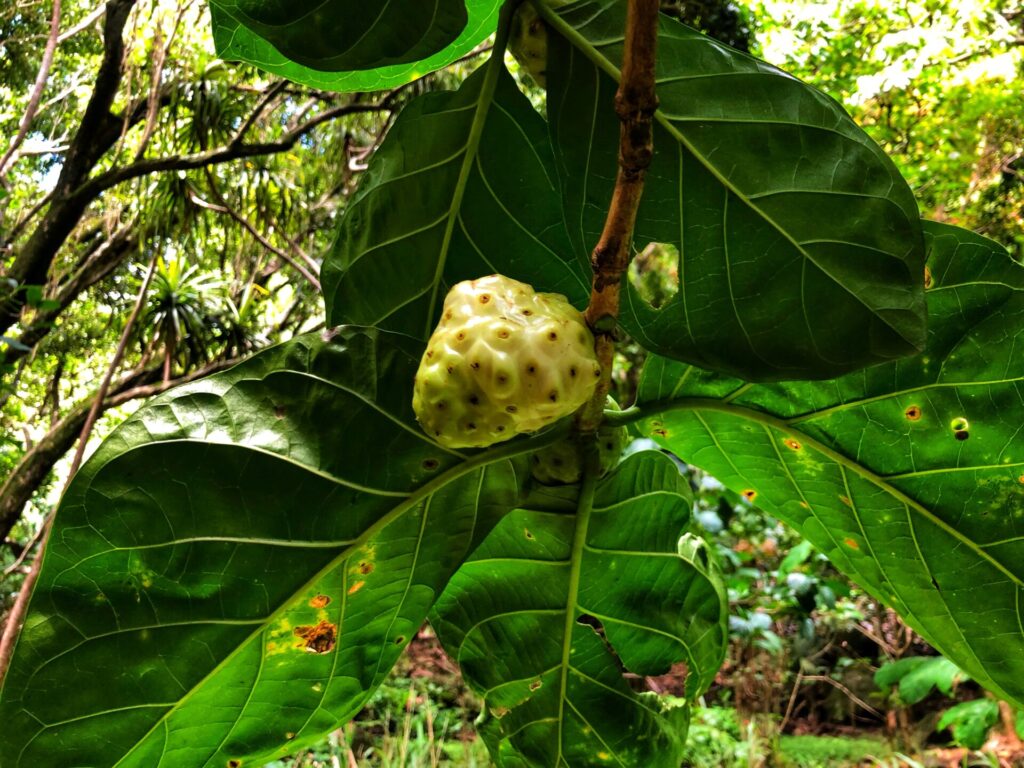 Something you may see along many coastal trails and beach parks is the noni tree. The fruit is edible, but it’s not something you’re going to want as a garnish to your cocktail. It’s an admittedly acquired taste and is medicinal rather than snackable. It’s native to southeast Asia, but is another example of a canoe plant brought by the Polynesians who valued it for is medicinal qualities. Though it can be eaten raw and is prepared in other parts of the world in dishes such as curries, it is generally considered a famine food. The fruit is ripe when it turns from yellow to an almost translucent white. The texture is somewhat waxy, as is the taste, and meant to be fermented in order to get its full potency. Note that while noni has been claimed to have an incredibly wide range of health benefits, it has not been studied or approved by the Food and Drug Administration. That being said, there’s plenty of people in Hawaii and around the world that have, for generations, sworn by it effectiveness. You can find it as an ingredient in tonics and smoothies in a few places across Hawaii, as well as a supplement in places like Longs CVS and Costco under the name Healing Noni.
Something you may see along many coastal trails and beach parks is the noni tree. The fruit is edible, but it’s not something you’re going to want as a garnish to your cocktail. It’s an admittedly acquired taste and is medicinal rather than snackable. It’s native to southeast Asia, but is another example of a canoe plant brought by the Polynesians who valued it for is medicinal qualities. Though it can be eaten raw and is prepared in other parts of the world in dishes such as curries, it is generally considered a famine food. The fruit is ripe when it turns from yellow to an almost translucent white. The texture is somewhat waxy, as is the taste, and meant to be fermented in order to get its full potency. Note that while noni has been claimed to have an incredibly wide range of health benefits, it has not been studied or approved by the Food and Drug Administration. That being said, there’s plenty of people in Hawaii and around the world that have, for generations, sworn by it effectiveness. You can find it as an ingredient in tonics and smoothies in a few places across Hawaii, as well as a supplement in places like Longs CVS and Costco under the name Healing Noni.
Soursop
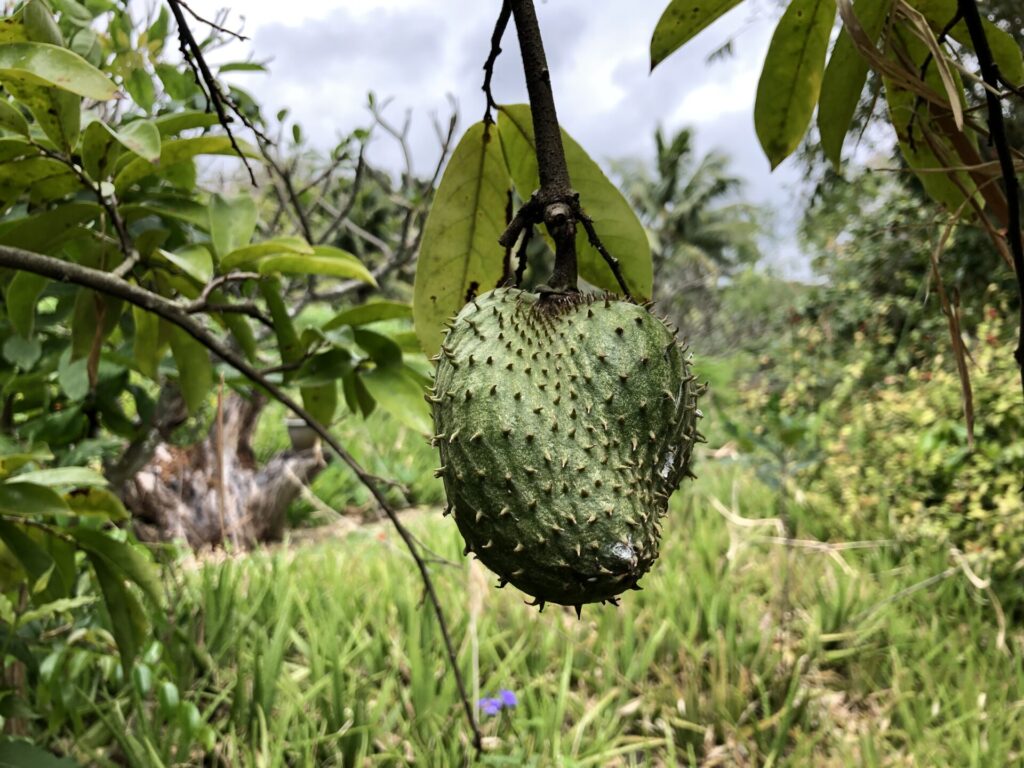 One of the more odd looking fruits you’ll come across in Hawaii is the soursop. Though originally from Central and South America, soursop is found all over the world in the tropics and is regularly included in tropical fruit juice mixes. (You may have heard of it by its Spanish name, guánabana.) Though it looks prickly, the skin is more rubbery than anything. The inside is soft and custard-like, with flavors akin to a mix of banana, pear and pineapple. As the name suggests, it definitely has a tang to it but is less pronounced the riper it is. It stays pretty green, but those at peak ripeness become slightly yellow. It’s a great source of vitamin C, plus a decent source of B vitamins an potassium. The young leaves are sometimes used as a tea, as well. The trees fruit several times through the year, but your best chance of finding them at the farmers market is in the springtime.
One of the more odd looking fruits you’ll come across in Hawaii is the soursop. Though originally from Central and South America, soursop is found all over the world in the tropics and is regularly included in tropical fruit juice mixes. (You may have heard of it by its Spanish name, guánabana.) Though it looks prickly, the skin is more rubbery than anything. The inside is soft and custard-like, with flavors akin to a mix of banana, pear and pineapple. As the name suggests, it definitely has a tang to it but is less pronounced the riper it is. It stays pretty green, but those at peak ripeness become slightly yellow. It’s a great source of vitamin C, plus a decent source of B vitamins an potassium. The young leaves are sometimes used as a tea, as well. The trees fruit several times through the year, but your best chance of finding them at the farmers market is in the springtime.
Lychee
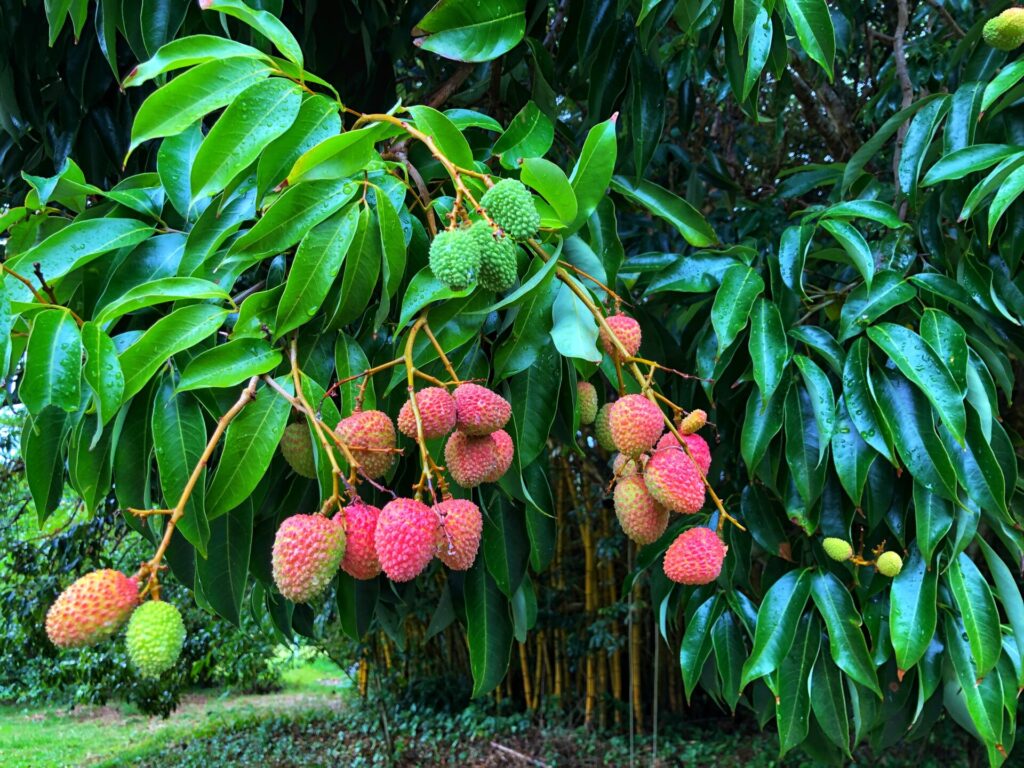 One of the absolute favorite fruits across Hawaii is the lychee. Lychee season tends to be mid spring to early summer, and if you see someone selling them on the roadside, do yourself a favor and stop to buy some. These small fruit are native to China and were brought to Hawaii by early plantation workers. If you’ve never tried one, you too will become a hopeless addict with the first bite. They have a red, woody and bumby skin that cracks and splits easily with a little pressure. The inside is colored a translucent white and is very similar to grape in texture. Note they have a seed inside that can range in size from nearly the size of the fruit itself, to the size of TicTac. (Those are unappetizingly called “rooster tongue” lychee.) They’re great on their own as well as in drinks. They very popular in margaritas and fruity martinis. They’re very similar to both longon (also called “dragon eyes”) and the wild-looking rambutan, but in my opinion lychee is the best example of this tropical fruit. You can find them canned (which is what is often used for cocktails), but they don’t come close to the flavor of fresh lychee.
One of the absolute favorite fruits across Hawaii is the lychee. Lychee season tends to be mid spring to early summer, and if you see someone selling them on the roadside, do yourself a favor and stop to buy some. These small fruit are native to China and were brought to Hawaii by early plantation workers. If you’ve never tried one, you too will become a hopeless addict with the first bite. They have a red, woody and bumby skin that cracks and splits easily with a little pressure. The inside is colored a translucent white and is very similar to grape in texture. Note they have a seed inside that can range in size from nearly the size of the fruit itself, to the size of TicTac. (Those are unappetizingly called “rooster tongue” lychee.) They’re great on their own as well as in drinks. They very popular in margaritas and fruity martinis. They’re very similar to both longon (also called “dragon eyes”) and the wild-looking rambutan, but in my opinion lychee is the best example of this tropical fruit. You can find them canned (which is what is often used for cocktails), but they don’t come close to the flavor of fresh lychee.
Passion Fruit aka Liliko‘i
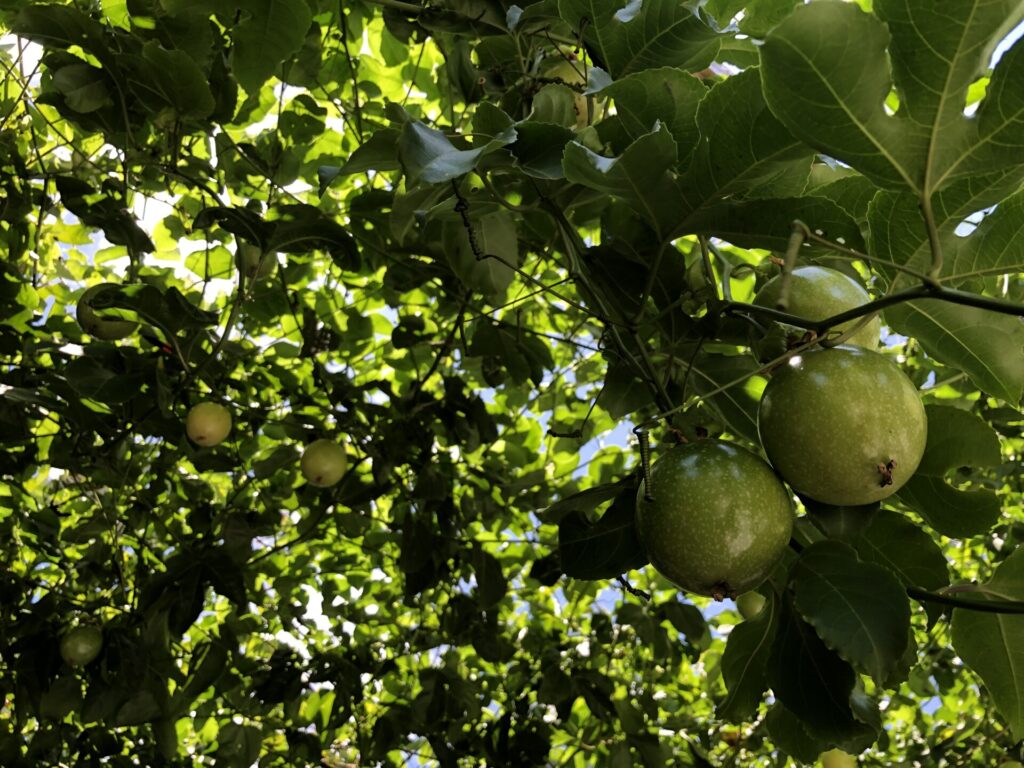 Passion fruit is so ingrained in Hawaii that it has its own Hawaiian name. It is used to flavor every kind of dessert you find here, such as malasadas (Portuguese-style donunts), cheesecakes and more. It’s also one of the key ingredients in the Hawaiian juice mix P.O.G. (If you didn’t know it’s an acronym, P.O.G. stands for passion fruit, orange and guava.) Native to South America, it’s ubiquitous nature is due to it being an invasive species. At least it’s a tasty invasive; though its vines can choke out plant life around it, its culinary qualities have given it a hall pass. The flowers are intricately beautiful and the fruit comes in a variety of colors. They all start out green, with the most common varieties turning yellow when ripe, though there’s a purple variety as well. The fruit is really a jelly-like substance that surrounds the numerous seeds inside the thick-skinned fruit. The flavor can be surprisingly tart. Another variety that is orange in color, more oblong in shape and has is sometimes called Tahitian or Jamaican liliko‘i is much sweeter and should tried any time you have the chance. A third variety that is especially invasive and not especially flavorful is locally called banana poka. The banana part comes from its long, slender shape and the fact that it also turns yellow when ripe. All varieties produce so much fruit that you can often find them at roadside stands for as little as a quarter a piece.
Passion fruit is so ingrained in Hawaii that it has its own Hawaiian name. It is used to flavor every kind of dessert you find here, such as malasadas (Portuguese-style donunts), cheesecakes and more. It’s also one of the key ingredients in the Hawaiian juice mix P.O.G. (If you didn’t know it’s an acronym, P.O.G. stands for passion fruit, orange and guava.) Native to South America, it’s ubiquitous nature is due to it being an invasive species. At least it’s a tasty invasive; though its vines can choke out plant life around it, its culinary qualities have given it a hall pass. The flowers are intricately beautiful and the fruit comes in a variety of colors. They all start out green, with the most common varieties turning yellow when ripe, though there’s a purple variety as well. The fruit is really a jelly-like substance that surrounds the numerous seeds inside the thick-skinned fruit. The flavor can be surprisingly tart. Another variety that is orange in color, more oblong in shape and has is sometimes called Tahitian or Jamaican liliko‘i is much sweeter and should tried any time you have the chance. A third variety that is especially invasive and not especially flavorful is locally called banana poka. The banana part comes from its long, slender shape and the fact that it also turns yellow when ripe. All varieties produce so much fruit that you can often find them at roadside stands for as little as a quarter a piece.
This is just a small sample of the exotic fruits you can find in Hawaii. Be on the lookout for future blogs where I’ll tell you about some other island fruits to be on the lookout for. Check out my guidebooks and apps for even more descriptions of what to find in Hawaii and beyond. My believable guides will help you have an unbelievable vacation.




0 Comments